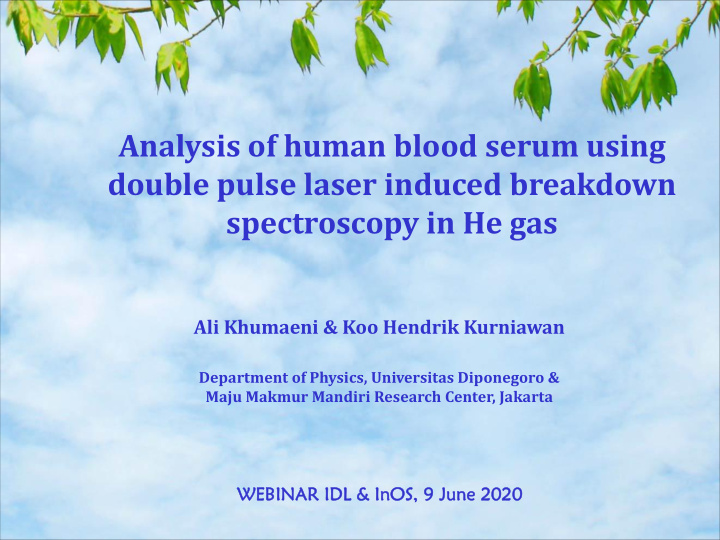



Analysis of human blood serum using double pulse laser induced breakdown spectroscopy in He gas Ali Khumaeni & Koo Hendrik Kurniawan Department of Physics, Universitas Diponegoro & Maju Makmur Mandiri Research Center, Jakarta WEBINAR IDL & InOS, 9 June 2020
Human blood serum q The red blood cells carry the oxygen, nutrients, waste products and carbon dioxide. The white blood cells fight off infections and help heal wounds. The blood platelets help the blood to clot. q The elemental analysis of human blood is significant in the routine clinical practice as well as in medical research. http://www.differencebetween.info/difference-between-blood-and-serum The elemental concentration levels of blood serum may indicate certain diseases; therefore, their determination is useful for establishing diagnosis. 2
General methods for liquid serum analysis ICP MS ICP AES High Frequency Plasma Serum sample Liquid sample ü Delicate sample preparation ü Labor intensive ? ü Expensive in experimental ü Rapid analysis ü Without/less sample instrumentation preparation ü Not mobile system
Atomic Emission Spectroscopy Laser-Induced Breakdown Spectroscopy (LIBS) The main advantage: Experimental setup Direct analysis without pretreatment (in-situ target analysis). LASER Micro-area analysis. Time Low cost compared to Controller OMA other analytical tools. fiber Pulsed Nd:YAG laser is usually used HIGH PRESSURE LOW PRESSURE GAS PLASMA 15-20 mm 10-15 mm 2-3 mm T o realize in-situ Strong continues plasma emits Background emission is very low http://www.utopiales.org analysis, 1 atm is required Mars mission Cremers & Radziemski’s Kagawa & Kurniawan’s Group Group, 1981 4
Laser-induced breakdown spectroscopy (LIBS) system 5
Mechanism of laser plasma generation Damage on sample surface Wavelength : 1.06 um Nd:YAG laser Pulse : 8-10 ns Power density is e approximately 10-100 GW/cm 2 + e e + + e e e + e e e + e + + e e + + e + e e + e e + + e + e e + + + e e + + e e + + e + + e e e + + e e + e + e + + e e + + + + + Absorption Atoms are ablated Primary plasma Shock wave plasma 6
Experimental setup Nd:YAG laser beam Luminous plasma Blood serum film Metal subtarget 7
Emission spectrum of blood serum using single pulse LIBS in air 8
Emission spectrum of blood serum using single pulse LIBS in He 9
Emission spectrum of blood serum using double pulse LIBS-He meta stable atoms 10
Energy dependence and Emission stability of element intensities in blood serum using single pulse 300 400 5000 C I 247.8 nm C I 247.8 nm Ca II 393.3 nm Ca II 393.3 nm 250 4000 O I 777.7 nm 300 O I 777.7 nm 200 H I 656.3 nm H I 656.3 nm 3000 S/N ratio S/N ratio 200 150 2000 100 100 1000 50 0 0 0 0 10 20 30 40 50 20 40 60 80 Number of laser shots Laser energy (mJ) 11
Emission intensity and LoD of elements in blood serum using single and double pulse LIBS-He Elements Standard LIBS Standard LIBS double double Intensity (Au) LoD pulse LIBS pulse LIBS (ppm) Intensity LoD (Au) (ppm) Ca I 422.6 nm 6100 1.25 17400 0.39 Mg I 285.2 nm 650 3.55 3280 0.69 K I 766.5 nm 920 14.8 4200 3.25 Na I 588.9 nm 16000 14.66 60000 3.91 Fe I 371.9 nm 1329 10.53 2000 7.35 12
Conclusion q Analysis of elements in human blood serum has been made using double pulse laser-induced breakdown spectroscopy (LIBS) in He gas. q Identification of C, C-N, H, Na, Ca, Mg, K, Fe, and N from the human blood serum can rapidly be carried out by using the present technique. q Good emission stability of anlyte intensity was obtained using the present technique. q Enhancement of emission intensity happens of around 4-6 time for the case of double pulse LIBS compared to standard single pulse LIBS. q The LoD of analyte is much better for double pulse LIBS compared to single pulse LIBS. q This present technique is very potential to be applied for diagnose of human disease such as tuberculosis. 13
Thank You 14
Recommend
More recommend